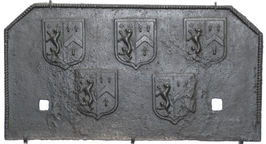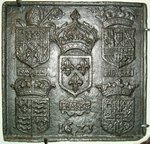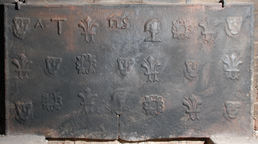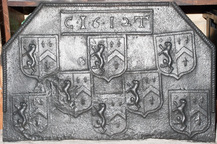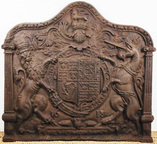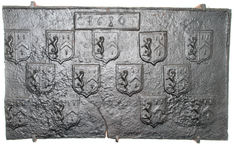-
741
Description: Rectangular, with canted top corners; twisted rope edging (top and sides only); five shields of Ayloffe impaling Sulyard in two rows, 3-2; Ayloffe: sable, a lion rampant Or, collared gules, between three crosses formy of the second; Sulyard: argent, a chevron gules between three pheons inverted sable. Two cut notches probably for firedogs.
Notes: William Ayloffe (c1535-1584) of Bretons, Hornchurch, Essex, Justice of the Court of Queen’s Bench, married (c1560) Jane, dau. of Sir Eustace Sulyard, of Runwell, Essex. A large number of variants use the same shields. The excrescences affecting the left and right sides respectively of the lower shields are the result of inexpert ladling of the iron during casting. Part of the bequest to the Victoria and Albert Museum by Lieut. Colonel G. B. Croft-Lyons in 1926.
Arms: Ayloffe impaling Sulyard (William Ayloffe of Bretons, Hornchurch)
- Decoration tags:
- rectangular with canted top corners (shape)
- rope (edging)
- carved stamps
- armorial
Manufactured: in the early-17th century in the Weald area of England.
Current location: Victoria & Albert Museum, Cromwell Road, Kensington & Chelsea, Greater London, England.
Museum number: M.621-1926 (part of the Victoria & Albert Museum museum group)
- Attached to series:
- Ayloffe series
- Personal armorial firebacks
- Andiron slot firebacks
-
1171
Description: Rectangular shape; fillet edging; arrangement of five shields: centre, arms of the kingdom of France surmounted by a crown and, below, the word FRANCE on a fillet edged rectangular block over a cartouche; top left, arms of the duchy of Lorraine surmounted by a bishop's mitre and crozier separating a largely illegible text; top right, arms of the kingdom of Spain surmounted by a crown with the letters SPA to the left; bottom right, arms of the duchy of Nevers surmounted by a coronet below a fillet edged rectangle with the word NEVERS; bottom left, arms of the kingdom of England surmounted by a crown below a fillet edged rectangle with the word ANGLIA; bottom centre, the date 1623.
Notes: A taque de foyer or takenplatte; the arms in the corners are likely to be of (from top left): Louis III of Lorraine, Archbishop of Reims; King Philip III of Spain; Charles I, Duke of Nevers and Rethel; and Queen Elizabeth I of England. A similar fireback with the same arms, illustrated by von den Driesch (1990, p.181), has the date 1611, but the absence of a cardinal's hat over the arms of Louis of Lorraine suggests that the fireback originally dates from before 1605.
Inscription: [LORR]AI[NE] SPA / ANGLIA NEVERS / FRANCE / 16z3
Arms: Louis of Lorraine; Kingdom of Spain; Kingdom of France; Kingdom of England; Charles Gonzaga, Duke of Nevers
- Decoration tags:
- rectangular (shape)
- fillet (edging)
- whole carved pattern
- individual numbers
- heraldic
- armorial
- royal
- text
Manufactured: in 1623 possibly in the Ardennes area of Belgium.
Current location: Musée Gaumais, 38 Rue d'Arlon, Virton, Luxembourg, Belgium.
(part of the Musée Gaumais, Virton museum group)
- Attached to series:
- Foreign armorial firebacks
-
801
Description: Rectangular; twisted rope edging (top and sides); irregular arrangement of four stamps in three rows: face mask with ruff (7), flower head with four petals and leaflets (4), fleur-de-lys (7), and profile of head with ‘Roman’ crest (2); initials replace stamps top left and centre.
Notes: A smaller, dated variant is at Godolphin House, Helston.
Copies of this fireback are known.
Inscription: AT nS
- Decoration tags:
- rectangular (shape)
- rope (edging)
- carved stamps
- individual letters
- heraldic
- text
- humans
- plants
Manufactured: in the early-17th century in the Weald area of England.
Current location: The Dorset Arms, Withyham, East Sussex, England.
Citation: Lloyd, N., 1925, 'Domestic Ironwork I', Architectural Review, 58, pp. 58-67.
- Attached to series:
- Primitive stamp series
-
1192
Description: Canted rectangular shape; twisted rope edging formed of six lengths of 23cm (top and sides); top centre, rectangular panel with cavetto-moulded edging (left side missing) enclosing date between initials CT, all interposed with dots; below, eight shields of Ayloffe impaling Sulyard in three rows (3-2-3); Ayloffe: sable, a lion rampant Or, collared gules, between three crosses formy of the second; Sulyard: argent, a chevron gules between three pheons inverted sable.
Notes: William Ayloffe (c1535-1584) of Bretons, Hornchurch, Essex, Justice of the Court of Queen’s Bench, married (c1560) Jane, dau. of Sir Eustace Sulyard, of Runwell, Essex. The initials 'CT' are likely to be those of Charles Tyler, a founder whose working life and that of his family have strong parallels with the occurrence of these firebacks. The excrescence affecting the left shield in the middle row and the blemish left of the middle shield in the top row are the result of inexpert ladling of the iron during casting. Previously at Smarden, Kent. The absence of the left side of the frame of the inscription panel has also been noted on another back in this series, also dated 1612.
Inscription: C.1.6.1.2.T
Arms: Ayloffe impaling Sulyard (William Ayloffe of Bretons, Hornchurch)
- Decoration tags:
- rectangular with canted top corners (shape)
- rope (edging)
- carved stamps
- individual letters
- individual numbers
- heraldic
- armorial
- text
Manufactured: in 1612 possibly at Bedgebury Furnace, Goudhurst in the Weald area of England.
Current location: in private hands, Crawley, West Sussex, England.
- Attached to series:
- Ayloffe series
- Personal armorial firebacks
-
254
Description: Curved ogee-arched rectangular with egg and dart moulding along top, supported by Ionic pilasters; English Stuart royal shield, garter, helm, crown, motto and supporters; date below and either side of garter.
Notes: One of several firebacks, all of the same date, but varying in size, framing style and moulding; all have stylistic features in common and will have been the work of the same pattern maker, who was also responsible for carving royal coats of arms in three West Country churches. A casting of this design serves as a royal armorial in St Lawrence's church, Bigbury, Devon.
Copies of this fireback are known.
Inscription: HONI + SOIT + QVI + MAL + Y + PENSE / 16 18
Arms: English Stuart royal (James I)
- Decoration tags:
- rectangular with round arch (shape)
- complex individual (edging)
- whole carved pattern
- planklines
- armorial
- royal
- text
Manufactured: in 1618 possibly in the Forest of Dean area of England.
Current location: not known.
-
1008
Description: Rectangular; twisted rope edging on top and (probably both) sides; cavetto-moulded-edged rectangle top centre, enclosing date between initials; 13 shields of Ayloffe impaling Sulyard in three rows (5-4-4), the bottom row having a gap between the middle pair of shields; Ayloffe: sable, a lion rampant Or, collared gules, between three crosses formy of the second; Sulyard: argent, a chevron gules between three pheons inverted sable.
Notes: William Ayloffe (c1535-1584) of Bretons, Hornchurch, Essex, Justice of the Court of Queen’s Bench, married (c1560) Jane, dau. of Sir Eustace Sulyard, of Runwell, Essex. About 110mm of the left side has broken off suggesting an original width of 1340mm. The initials 'CT' are likely to be those of Charles Tyler, a founder whose working life and that of his family have strong parallels with the occurrence of these firebacks.
Inscription: C 1610 T
Arms: Ayloffe impaling Sulyard (William Ayloffe of Bretons, Hornchurch)
- Decoration tags:
- rectangular (shape)
- rope (edging)
- carved stamps
- individual letters
- individual numbers
- armorial
- text
Manufactured: in 1610 possibly at Bedgebury Furnace, Goudhurst in the Weald area of England.
Current location: Wye College, High Street, Wye, Kent, England.
- Attached to series:
- Ayloffe series
- Personal armorial firebacks
